With Halloween and Thanksgiving behind us (see Top 5 Halloween Pet Safety Tips and Thanksgiving Holiday Pet Safety Tips), the fall-winter holiday season forges forward with the festivities of Hanukkah, Christmas and New Year’s Eve. As we decorate our dwellings for these celebrations, keep in mind that festive plants can be potentially toxic when eaten by your pets. As friends and family share the holiday cheer by gifting (or re-gifting) you a seasonal plant, be aware of the toxic effects a particular plant may have on your pet if inappropriately consumed.
Here is my list of common winter holiday plants and the clinical signs our canine and feline companions can exhibit post-ingestion.
Amaryllis (Amaryllis sp.)
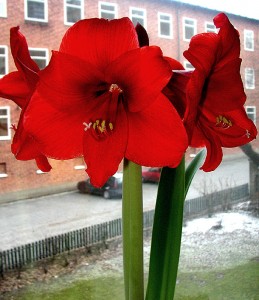 The Amaryllis is a personal favorite, as any novice green thumb has only to provide appropriate water and light to generate a spectacular flower. I enjoy watching the stalk thrust skyward from its earthen bulb and produce trumpet-shaped blossoms. Unfortunately, the beauty of the Amaryllis is matched by its potential to be toxic.
The Amaryllis contains Lycorine and other noxious substances, which can cause increased salivation, gastrointestinal abnormalities (vomiting, diarrhea, decreased appetite, and abdominal pain), lethargy, and tremors in both cats and dogs. The bulb of the plant is reputed to be more toxic than the flowers and stalk. The Amaryllis also goes by other names, including the Belladonna or Saint Joseph Lily, the Cape Belladonna, and the Naked Lady.
Christmas Cactus (Schlumbergera bridgesii)
The Amaryllis is a personal favorite, as any novice green thumb has only to provide appropriate water and light to generate a spectacular flower. I enjoy watching the stalk thrust skyward from its earthen bulb and produce trumpet-shaped blossoms. Unfortunately, the beauty of the Amaryllis is matched by its potential to be toxic.
The Amaryllis contains Lycorine and other noxious substances, which can cause increased salivation, gastrointestinal abnormalities (vomiting, diarrhea, decreased appetite, and abdominal pain), lethargy, and tremors in both cats and dogs. The bulb of the plant is reputed to be more toxic than the flowers and stalk. The Amaryllis also goes by other names, including the Belladonna or Saint Joseph Lily, the Cape Belladonna, and the Naked Lady.
Christmas Cactus (Schlumbergera bridgesii)
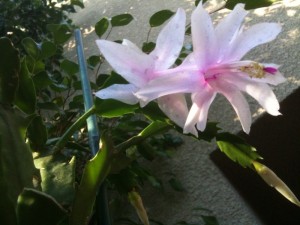 The Christmas Cactus is one of my favorite year-round plants. In fact, I have propagated my personal collection from larger plants hailing from Washington, Massachusetts, and Northern and Southern California. Of these four plants, only my Southern California variety produces the characteristic fuchsia flowers this holiday season (perhaps my green thumb is only a pale minty green?).
Much to my relief, my canine companion, Cardiff, is uninterested in consuming any of the vast array of plants I propagate. Fortunately, if he were to consume parts of a Christmas Cactus plant or flowers (or the plants relative, the Easter Cactus), he would suffer no directly toxic effects. The same lack of toxicity applies to cats. Yet, if the Christmas Cactus is consumed, the fibrous plant material causes mechanical irritation to the stomach and intestine, potentially leading to vomiting or diarrhea.
Holly (Ilex opaca)
The Christmas Cactus is one of my favorite year-round plants. In fact, I have propagated my personal collection from larger plants hailing from Washington, Massachusetts, and Northern and Southern California. Of these four plants, only my Southern California variety produces the characteristic fuchsia flowers this holiday season (perhaps my green thumb is only a pale minty green?).
Much to my relief, my canine companion, Cardiff, is uninterested in consuming any of the vast array of plants I propagate. Fortunately, if he were to consume parts of a Christmas Cactus plant or flowers (or the plants relative, the Easter Cactus), he would suffer no directly toxic effects. The same lack of toxicity applies to cats. Yet, if the Christmas Cactus is consumed, the fibrous plant material causes mechanical irritation to the stomach and intestine, potentially leading to vomiting or diarrhea.
Holly (Ilex opaca)
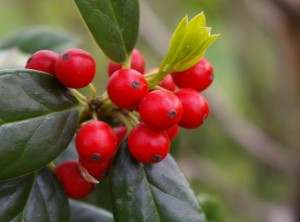 Your pet’s Christmas will not be so “holly-jolly” if the berries or leaves from the plant are consumed. Holly’s toxicity “stems from” (haha...botany joke) saponins, which are soap-like chemicals known as glycosides. In dogs and cats, consumption of Holly can cause gastrointestinal signs (decreased appetite, vomiting, or diarrhea) and lethargy.
House Pine (Araucaria heterophylla)
Your pet’s Christmas will not be so “holly-jolly” if the berries or leaves from the plant are consumed. Holly’s toxicity “stems from” (haha...botany joke) saponins, which are soap-like chemicals known as glycosides. In dogs and cats, consumption of Holly can cause gastrointestinal signs (decreased appetite, vomiting, or diarrhea) and lethargy.
House Pine (Araucaria heterophylla)
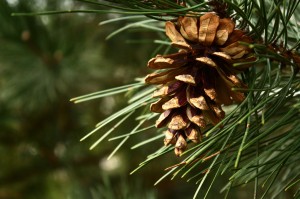 As a child and young adult, I loved the self imposed responsibility of decorating my family’s pine tree with a well practiced method of light and decoration placement creating visual depth and evoking nostalgia for all those that beheld our Christmas conifer (needless to say, I was an unusual child). Not until I started working as a technician in a veterinary hospital did I consider the possible toxic effects pine trees can have on our companion animals.
There are a variety of pine trees potentially causing toxicity, including the Australian, Norfolk, and Norfolk Island Pine. Unlike the other plants in this list, the toxic mechanism is unknown. Ingestion of pine needles can cause gastrointestinal signs and lethargy.
Even more potentially toxic is the water which nourishes our trees. The standing water can harbor bacteria, molds, or other agents (fertilizers) that can cause your pet to become extremely sick with only a few sips.
Mistletoe "American or European" (Phoradendron flavescens)
As a child and young adult, I loved the self imposed responsibility of decorating my family’s pine tree with a well practiced method of light and decoration placement creating visual depth and evoking nostalgia for all those that beheld our Christmas conifer (needless to say, I was an unusual child). Not until I started working as a technician in a veterinary hospital did I consider the possible toxic effects pine trees can have on our companion animals.
There are a variety of pine trees potentially causing toxicity, including the Australian, Norfolk, and Norfolk Island Pine. Unlike the other plants in this list, the toxic mechanism is unknown. Ingestion of pine needles can cause gastrointestinal signs and lethargy.
Even more potentially toxic is the water which nourishes our trees. The standing water can harbor bacteria, molds, or other agents (fertilizers) that can cause your pet to become extremely sick with only a few sips.
Mistletoe "American or European" (Phoradendron flavescens)
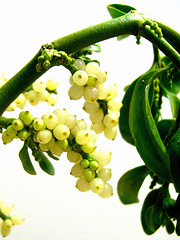 Mistletoe often gets incorporated into Christmas and New Year celebrations as an accessory to amorous advances. Was your partner’s kiss under the Mistletoe worth it upon discovery of your pet ingesting the Mistletoe you inadvertently dropped in the midst of your lustful swoon.
Mistletoe contains multiple substances toxic to both dogs and cats, including oxalbumin and pharatoxin viscumin (Lectins, Phoratoxins). Consumption of mistletoe berries or leaves can cause severe gastrointestinal, cardiovascular (low blood pressure, low heart rate), and neurologic (collapse, unusual behavior) signs.
Poinsettia (Euphorbia pulcherrima)
Mistletoe often gets incorporated into Christmas and New Year celebrations as an accessory to amorous advances. Was your partner’s kiss under the Mistletoe worth it upon discovery of your pet ingesting the Mistletoe you inadvertently dropped in the midst of your lustful swoon.
Mistletoe contains multiple substances toxic to both dogs and cats, including oxalbumin and pharatoxin viscumin (Lectins, Phoratoxins). Consumption of mistletoe berries or leaves can cause severe gastrointestinal, cardiovascular (low blood pressure, low heart rate), and neurologic (collapse, unusual behavior) signs.
Poinsettia (Euphorbia pulcherrima)
 This ubiquitous Christmas plant has an unnecessarily bad reputation for toxicity. As the Poinsettia is such a ubiquitous holiday decoration, it is frequently ingested by our pets.
Fortunately, toxicology studies do not confirm the public’s perception of the poinsettia’s exceedingly harmful effects. It is still best that your pet does not eat any part of the plant, as the poinsettia contains a latex-like sap that can cause local irritation to the mouth and vomiting.
Prevention and treatment of holiday plant ingestion
Ultimately, the best method of preventing inappropriate ingestion of a toxic plant by your pet is not allow these plants to be brought into your home, despite the altruistic intentions of your guests. Alternatively, you can obstruct your pet’s access (especially in your absence) and train your pet to avoid the plant using positive reinforcement.
If your pet is showing signs of illness in the presence of a potentially toxic plant, consider the likelihood that your pet could be sick from inappropriate ingestion of the plant. With any such suspicions, contact the ASPCA Animal Poison Control Center to determine the best treatment. As there are numerous plants that may harbor toxic effects, please visit APSCA APC for more information on and pictures of these potentially hazardous plants.
Keep in mind that more than one toxic substance can be involved, therefore seeking an Animal Poison Control Center consultation and pursuing treatment with a veterinarian are vitally important.
Thank you for reading my article. To receive my next article via email, please press the “Don’t Miss a Blog Post” button on the right upper corner of this page or follow this link.
Copyright of this article (2010) is owned by Dr. Patrick Mahaney, Veterinarian and Certified Veterinary Acupuncturist. Republishing any portion of this article must first be authorized by Dr. Patrick Mahaney. Requests for republishing must be approved by Dr. Patrick Mahaney and received in written format.
This ubiquitous Christmas plant has an unnecessarily bad reputation for toxicity. As the Poinsettia is such a ubiquitous holiday decoration, it is frequently ingested by our pets.
Fortunately, toxicology studies do not confirm the public’s perception of the poinsettia’s exceedingly harmful effects. It is still best that your pet does not eat any part of the plant, as the poinsettia contains a latex-like sap that can cause local irritation to the mouth and vomiting.
Prevention and treatment of holiday plant ingestion
Ultimately, the best method of preventing inappropriate ingestion of a toxic plant by your pet is not allow these plants to be brought into your home, despite the altruistic intentions of your guests. Alternatively, you can obstruct your pet’s access (especially in your absence) and train your pet to avoid the plant using positive reinforcement.
If your pet is showing signs of illness in the presence of a potentially toxic plant, consider the likelihood that your pet could be sick from inappropriate ingestion of the plant. With any such suspicions, contact the ASPCA Animal Poison Control Center to determine the best treatment. As there are numerous plants that may harbor toxic effects, please visit APSCA APC for more information on and pictures of these potentially hazardous plants.
Keep in mind that more than one toxic substance can be involved, therefore seeking an Animal Poison Control Center consultation and pursuing treatment with a veterinarian are vitally important.
Thank you for reading my article. To receive my next article via email, please press the “Don’t Miss a Blog Post” button on the right upper corner of this page or follow this link.
Copyright of this article (2010) is owned by Dr. Patrick Mahaney, Veterinarian and Certified Veterinary Acupuncturist. Republishing any portion of this article must first be authorized by Dr. Patrick Mahaney. Requests for republishing must be approved by Dr. Patrick Mahaney and received in written format.
 The Amaryllis is a personal favorite, as any novice green thumb has only to provide appropriate water and light to generate a spectacular flower. I enjoy watching the stalk thrust skyward from its earthen bulb and produce trumpet-shaped blossoms. Unfortunately, the beauty of the Amaryllis is matched by its potential to be toxic.
The Amaryllis contains Lycorine and other noxious substances, which can cause increased salivation, gastrointestinal abnormalities (vomiting, diarrhea, decreased appetite, and abdominal pain), lethargy, and tremors in both cats and dogs. The bulb of the plant is reputed to be more toxic than the flowers and stalk. The Amaryllis also goes by other names, including the Belladonna or Saint Joseph Lily, the Cape Belladonna, and the Naked Lady.
Christmas Cactus (Schlumbergera bridgesii)
The Amaryllis is a personal favorite, as any novice green thumb has only to provide appropriate water and light to generate a spectacular flower. I enjoy watching the stalk thrust skyward from its earthen bulb and produce trumpet-shaped blossoms. Unfortunately, the beauty of the Amaryllis is matched by its potential to be toxic.
The Amaryllis contains Lycorine and other noxious substances, which can cause increased salivation, gastrointestinal abnormalities (vomiting, diarrhea, decreased appetite, and abdominal pain), lethargy, and tremors in both cats and dogs. The bulb of the plant is reputed to be more toxic than the flowers and stalk. The Amaryllis also goes by other names, including the Belladonna or Saint Joseph Lily, the Cape Belladonna, and the Naked Lady.
Christmas Cactus (Schlumbergera bridgesii)
 The Christmas Cactus is one of my favorite year-round plants. In fact, I have propagated my personal collection from larger plants hailing from Washington, Massachusetts, and Northern and Southern California. Of these four plants, only my Southern California variety produces the characteristic fuchsia flowers this holiday season (perhaps my green thumb is only a pale minty green?).
Much to my relief, my canine companion, Cardiff, is uninterested in consuming any of the vast array of plants I propagate. Fortunately, if he were to consume parts of a Christmas Cactus plant or flowers (or the plants relative, the Easter Cactus), he would suffer no directly toxic effects. The same lack of toxicity applies to cats. Yet, if the Christmas Cactus is consumed, the fibrous plant material causes mechanical irritation to the stomach and intestine, potentially leading to vomiting or diarrhea.
Holly (Ilex opaca)
The Christmas Cactus is one of my favorite year-round plants. In fact, I have propagated my personal collection from larger plants hailing from Washington, Massachusetts, and Northern and Southern California. Of these four plants, only my Southern California variety produces the characteristic fuchsia flowers this holiday season (perhaps my green thumb is only a pale minty green?).
Much to my relief, my canine companion, Cardiff, is uninterested in consuming any of the vast array of plants I propagate. Fortunately, if he were to consume parts of a Christmas Cactus plant or flowers (or the plants relative, the Easter Cactus), he would suffer no directly toxic effects. The same lack of toxicity applies to cats. Yet, if the Christmas Cactus is consumed, the fibrous plant material causes mechanical irritation to the stomach and intestine, potentially leading to vomiting or diarrhea.
Holly (Ilex opaca)
 Your pet’s Christmas will not be so “holly-jolly” if the berries or leaves from the plant are consumed. Holly’s toxicity “stems from” (haha...botany joke) saponins, which are soap-like chemicals known as glycosides. In dogs and cats, consumption of Holly can cause gastrointestinal signs (decreased appetite, vomiting, or diarrhea) and lethargy.
House Pine (Araucaria heterophylla)
Your pet’s Christmas will not be so “holly-jolly” if the berries or leaves from the plant are consumed. Holly’s toxicity “stems from” (haha...botany joke) saponins, which are soap-like chemicals known as glycosides. In dogs and cats, consumption of Holly can cause gastrointestinal signs (decreased appetite, vomiting, or diarrhea) and lethargy.
House Pine (Araucaria heterophylla)
 As a child and young adult, I loved the self imposed responsibility of decorating my family’s pine tree with a well practiced method of light and decoration placement creating visual depth and evoking nostalgia for all those that beheld our Christmas conifer (needless to say, I was an unusual child). Not until I started working as a technician in a veterinary hospital did I consider the possible toxic effects pine trees can have on our companion animals.
There are a variety of pine trees potentially causing toxicity, including the Australian, Norfolk, and Norfolk Island Pine. Unlike the other plants in this list, the toxic mechanism is unknown. Ingestion of pine needles can cause gastrointestinal signs and lethargy.
Even more potentially toxic is the water which nourishes our trees. The standing water can harbor bacteria, molds, or other agents (fertilizers) that can cause your pet to become extremely sick with only a few sips.
Mistletoe "American or European" (Phoradendron flavescens)
As a child and young adult, I loved the self imposed responsibility of decorating my family’s pine tree with a well practiced method of light and decoration placement creating visual depth and evoking nostalgia for all those that beheld our Christmas conifer (needless to say, I was an unusual child). Not until I started working as a technician in a veterinary hospital did I consider the possible toxic effects pine trees can have on our companion animals.
There are a variety of pine trees potentially causing toxicity, including the Australian, Norfolk, and Norfolk Island Pine. Unlike the other plants in this list, the toxic mechanism is unknown. Ingestion of pine needles can cause gastrointestinal signs and lethargy.
Even more potentially toxic is the water which nourishes our trees. The standing water can harbor bacteria, molds, or other agents (fertilizers) that can cause your pet to become extremely sick with only a few sips.
Mistletoe "American or European" (Phoradendron flavescens)
 Mistletoe often gets incorporated into Christmas and New Year celebrations as an accessory to amorous advances. Was your partner’s kiss under the Mistletoe worth it upon discovery of your pet ingesting the Mistletoe you inadvertently dropped in the midst of your lustful swoon.
Mistletoe contains multiple substances toxic to both dogs and cats, including oxalbumin and pharatoxin viscumin (Lectins, Phoratoxins). Consumption of mistletoe berries or leaves can cause severe gastrointestinal, cardiovascular (low blood pressure, low heart rate), and neurologic (collapse, unusual behavior) signs.
Poinsettia (Euphorbia pulcherrima)
Mistletoe often gets incorporated into Christmas and New Year celebrations as an accessory to amorous advances. Was your partner’s kiss under the Mistletoe worth it upon discovery of your pet ingesting the Mistletoe you inadvertently dropped in the midst of your lustful swoon.
Mistletoe contains multiple substances toxic to both dogs and cats, including oxalbumin and pharatoxin viscumin (Lectins, Phoratoxins). Consumption of mistletoe berries or leaves can cause severe gastrointestinal, cardiovascular (low blood pressure, low heart rate), and neurologic (collapse, unusual behavior) signs.
Poinsettia (Euphorbia pulcherrima)
 This ubiquitous Christmas plant has an unnecessarily bad reputation for toxicity. As the Poinsettia is such a ubiquitous holiday decoration, it is frequently ingested by our pets.
Fortunately, toxicology studies do not confirm the public’s perception of the poinsettia’s exceedingly harmful effects. It is still best that your pet does not eat any part of the plant, as the poinsettia contains a latex-like sap that can cause local irritation to the mouth and vomiting.
Prevention and treatment of holiday plant ingestion
Ultimately, the best method of preventing inappropriate ingestion of a toxic plant by your pet is not allow these plants to be brought into your home, despite the altruistic intentions of your guests. Alternatively, you can obstruct your pet’s access (especially in your absence) and train your pet to avoid the plant using positive reinforcement.
If your pet is showing signs of illness in the presence of a potentially toxic plant, consider the likelihood that your pet could be sick from inappropriate ingestion of the plant. With any such suspicions, contact the ASPCA Animal Poison Control Center to determine the best treatment. As there are numerous plants that may harbor toxic effects, please visit APSCA APC for more information on and pictures of these potentially hazardous plants.
Keep in mind that more than one toxic substance can be involved, therefore seeking an Animal Poison Control Center consultation and pursuing treatment with a veterinarian are vitally important.
Thank you for reading my article. To receive my next article via email, please press the “Don’t Miss a Blog Post” button on the right upper corner of this page or follow this link.
Copyright of this article (2010) is owned by Dr. Patrick Mahaney, Veterinarian and Certified Veterinary Acupuncturist. Republishing any portion of this article must first be authorized by Dr. Patrick Mahaney. Requests for republishing must be approved by Dr. Patrick Mahaney and received in written format.
This ubiquitous Christmas plant has an unnecessarily bad reputation for toxicity. As the Poinsettia is such a ubiquitous holiday decoration, it is frequently ingested by our pets.
Fortunately, toxicology studies do not confirm the public’s perception of the poinsettia’s exceedingly harmful effects. It is still best that your pet does not eat any part of the plant, as the poinsettia contains a latex-like sap that can cause local irritation to the mouth and vomiting.
Prevention and treatment of holiday plant ingestion
Ultimately, the best method of preventing inappropriate ingestion of a toxic plant by your pet is not allow these plants to be brought into your home, despite the altruistic intentions of your guests. Alternatively, you can obstruct your pet’s access (especially in your absence) and train your pet to avoid the plant using positive reinforcement.
If your pet is showing signs of illness in the presence of a potentially toxic plant, consider the likelihood that your pet could be sick from inappropriate ingestion of the plant. With any such suspicions, contact the ASPCA Animal Poison Control Center to determine the best treatment. As there are numerous plants that may harbor toxic effects, please visit APSCA APC for more information on and pictures of these potentially hazardous plants.
Keep in mind that more than one toxic substance can be involved, therefore seeking an Animal Poison Control Center consultation and pursuing treatment with a veterinarian are vitally important.
Thank you for reading my article. To receive my next article via email, please press the “Don’t Miss a Blog Post” button on the right upper corner of this page or follow this link.
Copyright of this article (2010) is owned by Dr. Patrick Mahaney, Veterinarian and Certified Veterinary Acupuncturist. Republishing any portion of this article must first be authorized by Dr. Patrick Mahaney. Requests for republishing must be approved by Dr. Patrick Mahaney and received in written format.
